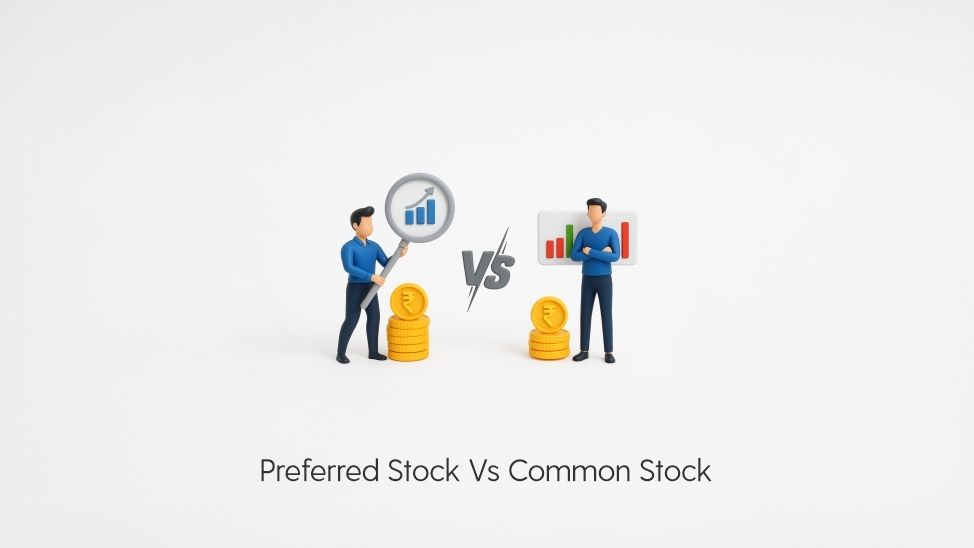Difference Between Common Stock and Preferred Stock

- Published Date: November 10, 2025
- Updated Date: November 21, 2025
- By Team Choice
When you, as an investor, buy stocks, you’re essentially purchasing ownership in a company. But not all stocks are created equal. The two most common types, common stock and preferred stock, offer distinct rights, benefits, and risks. Understanding the difference between common stock and preferred stock is essential for making informed investment decisions.
In this article, we’ll explore preferred stocks vs common stocks, their pros and cons, and how to decide which might suit your investment strategy better.
Understanding Common and Preferred Stocks
Before diving into their differences, let’s understand what common and preferred stocks are and how they function in the financial world.
What is a Common Stock?
Common stocks are the most common type of shares investors buy, representing partial ownership in a company. Shareholders may receive dividends, though these are not guaranteed, as many firms reinvest profits instead. Investors can benefit from potential long-term capital growth, but they also face higher risks. Common stockholders usually have voting rights in major company decisions, such as electing the board of directors. In liquidation, they are paid last after creditors and preferred shareholders, reflecting the higher risk and reward nature of common stock ownership.
What is a Preferred Stock?
Preferred stocks represent ownership in a company but typically do not include voting rights, setting them apart from common shares. They are often issued to raise capital and appeal to investors seeking stable income, as they usually offer a fixed dividend rate, scheduled payments, and sometimes a defined maturity period. Preferred shareholders have priority over common stockholders when it comes to receiving dividends and recovering assets during liquidation, giving them a more secure but generally less growth-oriented investment compared to common stock.
Difference Between Common Stock and Preferred Stock
The table below outlines all major difference between common and preferred stock
in detail:
| Basis of Difference | Common Stock | Preferred Stock |
|---|---|---|
| Voting Rights | Common shareholders usually have voting rights, allowing them to influence key company decisions and elect the board of directors. | Preferred shareholders generally do not have voting rights, though some special issues may include limited voting privileges. |
| Dividend Payments | Dividends are variable and not guaranteed; companies may choose to skip them depending on performance. | Dividends are fixed and paid regularly, offering predictable income to investors. |
| Dividend Priority | Paid after preferred shareholders, if at all. | Paid before any dividends are given to common shareholders. |
| Claim on Assets (During Liquidation) | Have the lowest priority in the event of company liquidation, paid after creditors and preferred shareholders. | Have a higher claim on company assets than common shareholders but lower than bondholders. |
| Risk Level | Higher risk due to price volatility and uncertainty in dividends. | Lower risk, as investors receive steady dividends and have priority in liquidation. |
| Return Potential | Potential for higher long-term returns through capital appreciation if the company performs well. | Returns are limited to fixed dividends; less potential for capital growth. |
| Price Volatility | More volatile - prices fluctuate widely with market movements and business performance. | Less volatile - prices remain relatively stable due to fixed fixed-income nature. |
| Convertibility | Common shares cannot be converted into another type of security. | Some preferred shares are convertible into common shares after a certain period or under specific conditions. |
| Ownership Rights | Full ownership rights, including participation in voting and profit-sharing. | Partial ownership rights, shareholders benefit from profits but have limited or no control. |
| Payment Obligation | Company is not obligated to pay dividends on common shares. | Company is expected to pay fixed dividends regularly before distributing any to common shareholders. |
| Investor Type Suitability | Suitable for growth-oriented investors seeking capital appreciation and long-term wealth creation. | Suitable for income-focused investors seeking stability and consistent dividends. |
Pros and Cons of Common Stock
Common stocks offer the chance for ownership and growth but come with risk.
| Advantages | Disadvantages |
|---|---|
| Voting Rights: Investors can vote on corporate matters and influence company direction. | Higher Risk: Common shareholders are last to receive payments during liquidation. |
| Capital Appreciation: Potential for higher returns if the company grows and performs well. | Uncertain Dividends: Payouts can be reduced or stopped anytime. |
| Dividend Growth: Some companies regularly increase dividends for common shareholders. | Market Volatility: Share prices can fluctuate significantly. |
Pros and Cons of Preferred Stock
Preferred stock is ideal for those who value predictable income and stability over control.
| Advantages | Disadvantages |
|---|---|
| Fixed Dividends: Provides steady income at set intervals. | Limited or No Voting Rights: Investors rarely have a say in company matters. |
| Priority in Payouts: Dividends are paid before those of common shareholders. | Capped Upside Potential: Share prices usually don’t increase much, even if the company performs well. |
| Less Volatile: Prices remain relatively stable compared to common shares. | Interest Rate Sensitivity: When interest rates rise, preferred stock prices often fall. |
Which Type of Stock Is Right for You?
Choosing between common stock and preferred stock depends largely on your investment goals, risk tolerance, and income expectations. Both play valuable roles in a diversified portfolio, but they serve different purposes.
Choose Common Stock if You Are:
- A long-term growth investor: Common stocks are ideal if your goal is to build wealth over time through capital appreciation.
- Comfortable with market fluctuations: Prices can rise and fall sharply, but over the long term, strong companies tend to reward shareholders with higher returns.
- Interested in company participation: Common stockholders often have voting rights, allowing them to influence corporate decisions such as electing directors or approving mergers.
- Not dependent on steady income: Dividends from common stocks are not guaranteed and can vary based on profits and company policy.
Choose Preferred Stock if You Are:
- Seeking stable income: Preferred stocks provide fixed dividends, making them attractive to income-oriented investors such as retirees or conservative investors.
- Looking for lower volatility: The prices of preferred shares generally remain more stable than common shares, offering peace of mind in uncertain markets.
- Prioritising safety in payouts: In case of liquidation or dividend distribution, preferred shareholders have priority over common shareholders.
- Less concerned about voting rights: Preferred stocks usually do not include voting privileges, meaning you get consistent returns but limited control.
Conclusion
Both common stocks and preferred stocks represent ownership in a company, but they cater to different investor needs. The difference between common stock and preferred stock boils down to trade-offs: growth potential versus income stability, and voting rights versus dividend security.
Before investing, assess your goals, understand each type’s risk, and consider consulting a financial advisor to create a balanced portfolio.
FAQs
1. What is common stock?
Common stock gives investors ownership in a company with voting rights. Returns come mainly from stock price appreciation and potential dividends.
2. What is preferred stock?
Preferred stock provides fixed dividend payments and has priority over common stock in receiving payouts, but it usually lacks voting rights.
3. What is the cost of preferred stock?
The cost of preferred stock is the dividend payment divided by the stock’s current market price. It represents the effective rate of return investors expect from holding the preferred shares.
4. Do both Preferred Stock and Common Stock have voting rights?
No. Common stockholders usually have voting rights, while preferred stockholders typically do not.
5. Which is better for investors, Preferred Stock vs Common Stock?
It depends on your investment goals. Common stock suits those seeking growth and influence in the company, while preferred stock fits income-focused investors who value stability and predictable returns.
Recommended for you

FII DII Data - Live Data

Share Market Prediction For Tomorrow

Market Prediction Today (23th December 2025)
